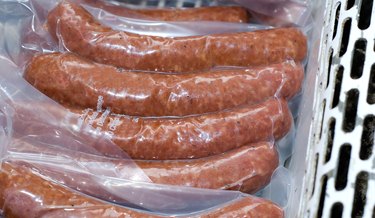
Food and drink products are packaged and sold in glass, plastic, aluminum and paper. Each of these materials has advantages and disadvantages for the consumer and the manufacturer.
Safety
Packaging food makes it safer and less vulnerable to contamination. Though the Food and Drug Administration has expressed concern about the safe use of recycled packaging, it is generally considered to be safe.
Shelf Life
Food lasts longer and stays fresh longer when it's packaged successfully. Unpackaged food can quickly become dry, moldy or spoiled.
Waste
Food packaging accounts for a large amount of all waste in the United States. Though some packaging is recyclable, it's difficult to improve the efficiency of most packaging.
Cost
Packaging accounts for a percentage of all food manufacturers' costs, and that is factored into the final price of each food product for the consumer.
Convenience
Single-serving packages and packaged perishable items are convenient because consumers don't have to wrap them up or put them in containers before storing them.